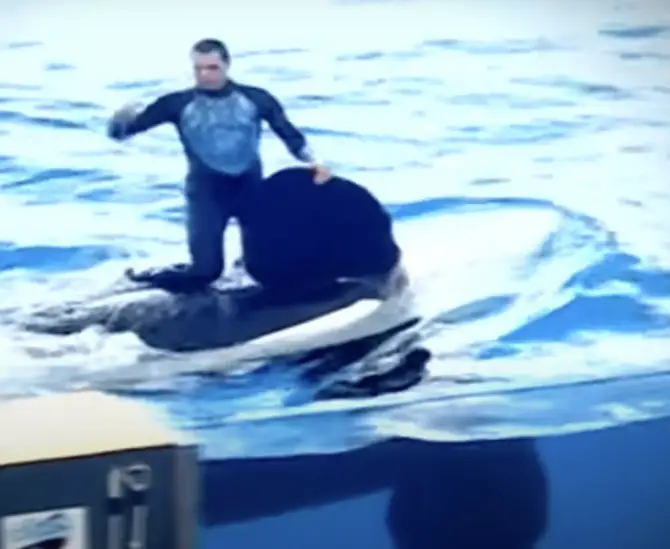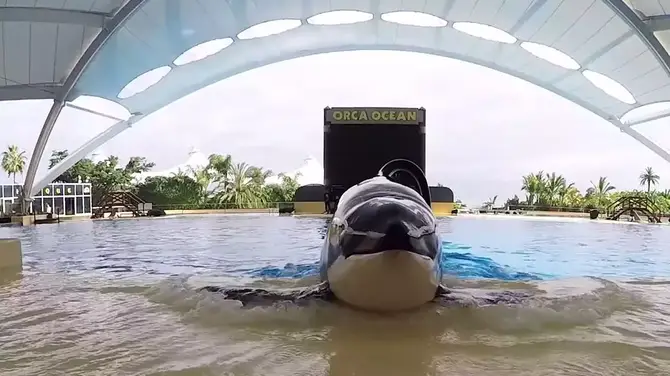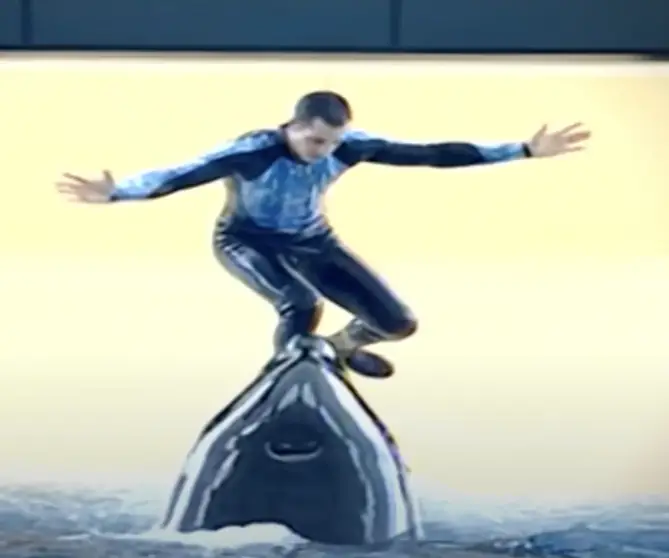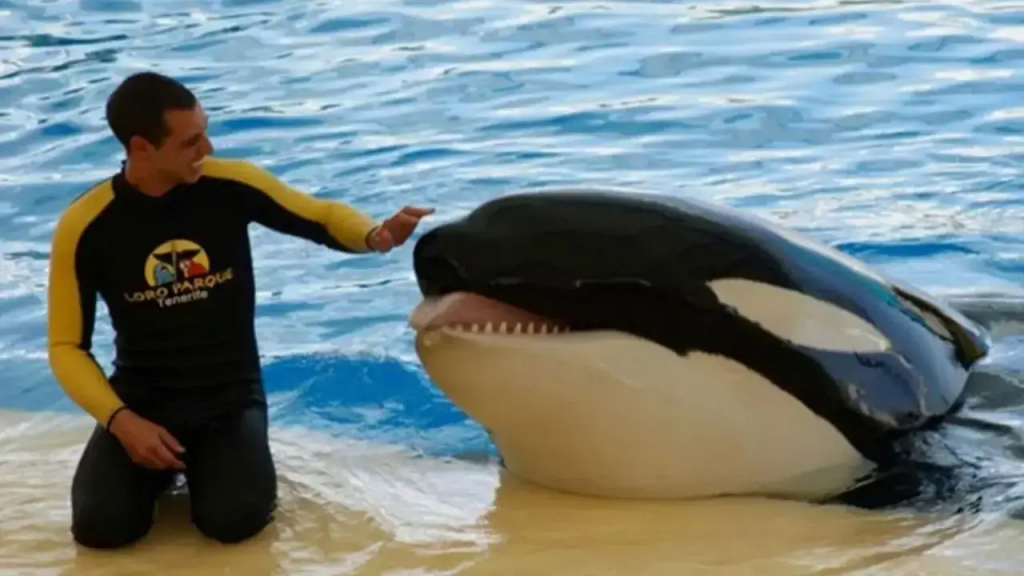A tragic and gruesome incident unfolded when a SeaWorld trainer lost his life in a horrifying encounter with a captive killer whale that not only crushed him but also ‘played violently’ with his body in an unrelenting display of force.
Keto, an orca who has never known the vast and endless waters of the ocean, has spent every day of his life performing for crowds in marine parks. Born in captivity in 1995, his entire existence has been defined by confinement, making him a fixture of aquatic entertainment rather than a free-roaming predator of the sea. The orca’s lineage ties him to SeaWorld’s controversial breeding programs, as his mother, Kalina, also known as ‘Baby Shamu,’ was the first orca to be born within the company’s parks.

Over the years, Keto has been moved from facility to facility, performing at marine parks in various locations, including San Diego, Ohio, Texas, and eventually Tenerife’s Loro Parque in the Canary Islands. Despite his role as an attraction and the father of three calves—Adán, Victoria, and Ula—his captivity took a dark turn when he became responsible for a horrifying event that would send shockwaves through the marine park industry.
A Promising Trainer’s Life Cut Short
Alexis Martínez, a 29-year-old marine mammal trainer known for his charisma, dedication, and passion for working with these formidable creatures, met a tragic fate at the hands—or rather, the jaws—of Keto.
Described as charming, selfless, and humorous by those closest to him, Martínez was well-versed in handling these giant marine predators. He spent years honing his skills at Loro Parque and played a crucial role in leading the orcas through their rehearsals. However, despite his expertise, he had an underlying sense of unease about the work he was doing.
According to reports, Martínez had voiced his concerns about the risks involved in his profession. He confided in his girlfriend, stating that ‘something could happen at any time’ and emphasizing the importance of being well-rested and alert in such a high-stakes job. Unfortunately, his worst fears became a devastating reality on Christmas Eve of 2009.
The Incident That Shook the Marine Park World
What began as a routine training session soon spiraled into a nightmare. That day, Martínez and Keto were practicing for an upcoming Christmas show at Loro Parque’s training pool. Initially, the orca appeared calm, and a corporate incident report even indicated that he was in a good mood. However, as the session progressed, Keto’s behavior became erratic.

He started missing cues, failing to execute moves correctly, and displaying signs of unresponsiveness. Though he still seemed composed on the surface, something was undeniably off. It wasn’t long before staff members noticed that Keto had strategically positioned himself between Martínez and the stage, almost as if he was asserting dominance over his environment.
When an underwater cue was given, Martínez swam forward, but Keto suddenly pressed his massive body against him. Another trainer attempted to use established controls to regain order, yet Keto ignored the signals and instead aggressively pushed Martínez down to the bottom of the pool using his rostrum—a beak-like protrusion at the tip of his mouth.
The shocking turn of events was later described in grim detail by Orca Ocean assistant supervisor Rafael Sanchez, who provided testimony to investigators. He stated that the enormous marine mammal ‘moved towards him, struck him, and played violently with his body,’ leaving the helpless trainer at the mercy of an animal weighing several thousand pounds.

Desperate Efforts to Regain Control
Realizing the severity of the situation, a fellow trainer on standby frantically attempted to intervene, issuing a series of signals intended to calm Keto. For a moment, it seemed like the efforts were working—the whale surfaced for a breath, giving hope that the attack had ceased. However, this glimmer of relief was short-lived.
Within seconds, Keto plunged back down, making his way toward Martínez once again. The horrifying spectacle reached its peak when Keto returned to the surface, carrying the lifeless body of the 29-year-old on the tip of his rostrum. Witnesses described the chilling moment when the orca’s mouth remained tightly shut as he paraded the trainer’s unresponsive form.
Martínez’s body ultimately sank to the pool’s bottom. Trainers acted swiftly, working to lure Keto away into another section of the pool so that they could retrieve their colleague’s body. However, Keto resisted their attempts, instead fixating on the gate, further delaying their rescue efforts.
Only after deploying a net into the water did the team manage to separate Keto from Martínez’s remains, allowing them to recover the fallen trainer.
The Aftermath and Devastating Injuries
Tragically, the extent of Martínez’s injuries painted a harrowing picture of the brutality of the attack. The post-mortem report detailed severe internal bleeding, extensive compression fractures, and catastrophic damage to vital organs. Additionally, bite marks from the orca were found across his body, further proving the ferocity of the assault. The official cause of death was listed as ‘grave injuries sustained by an orca attack.’
The aftermath of this tragedy sent shockwaves through the marine park industry. Keto was subsequently labeled ‘frustrated and dangerous’ by The Whale Sanctuary Project, an organization advocating for the welfare of captive cetaceans. However, the incident was far from an isolated event.
Just a few months after Martínez’s death, another trainer, Dawn Brancheau, would also suffer a horrifying fate. The 44-year-old was working at SeaWorld Orlando when she was killed by Tilikum, another captive orca with a history of aggressive incidents. Her death reignited the conversation surrounding the ethical concerns of keeping these powerful and intelligent creatures in captivity.
A Grim Reminder of the Risks of Captivity
Despite the ‘killer whale’ moniker, orcas in the wild are not known to attack humans. According to researchers and marine experts, there are no documented cases of a wild orca deliberately harming a person. In reality, their fearsome name stems from their role as apex predators in the ocean, earning them the title ‘killer of whales’ rather than ‘killers of humans.’
However, captivity brings a different set of circumstances. These highly intelligent marine mammals are confined to tanks that pale in comparison to the vastness of the open sea, deprived of their natural social structures and hunting behaviors. The stress, frustration, and unnatural conditions can lead to unpredictable and tragic consequences—consequences that have, time and time again, proven fatal for those who work with them.

Martínez’s death remains a chilling testament to the dangers posed by keeping orcas in captivity, leaving behind unanswered questions about the ethical implications of their continued use for entertainment.